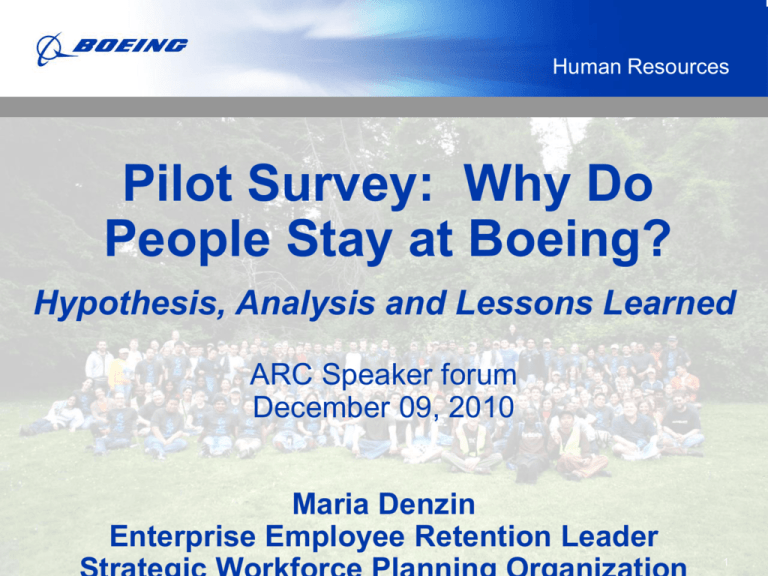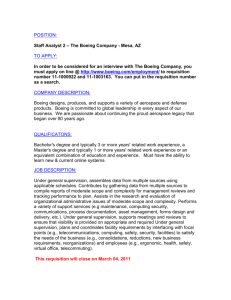
Human Resources
Pilot Survey: Why Do
People Stay at Boeing?
Hypothesis, Analysis and Lessons Learned
ARC Speaker forum
December 09, 2010
Maria Denzin
Enterprise Employee Retention Leader
BOEING is a trademark of Boeing Management Company.
Copyright © 2009 Boeing. All rights reserved.
1
Purpose of Today’s Meeting
Human Resources | Strategic Workforce Planning
Introduce the concept of the survey
Provide a high-level review of the “Why People Stay at
Boeing” survey process
Share Lessons Learned
Promote discussion
Copyright © 2009 Boeing. All rights reserved.
Background
Human Resources | Strategic Workforce Planning
0-5 YOS represent the highest level of voluntary attrition
in many companies
We had not previously captured the reasons why
employees decided to stay with Boeing
We have been heavily relying on exit survey data
Focus has been on attrition rather than retention
Managers need to understand how they can create a
retention culture
A decision was made to develop and distribute a survey
which would identify retention factors
Copyright © 2009 Boeing. All rights reserved.
Exit Data Alone May Not Tell the Whole Story
About Attrition or Retention
Human Resources | Strategic Workforce Planning
Data captures employee attrition, but doesn’t explain
retention.
Data may not be an accurate indicator of the real
reasons people leave
Excellent employees are always a target in talent
competition
Exit Survey process is variable
Copyright © 2009 Boeing. All rights reserved.
Hypotheses
Human Resources | Strategic Workforce Planning
The Boeing 0-5 YOS employee responses would be
similar to external research populations
Many of the factors that influence retention of 0-5 YOS
employees will be similar to Gen Y preferences per
literature
Management behaviors would be a significant factor
leading to “stay” behaviors
0-5 YOS employees top reason to stay would be
because of opportunities to develop their careers
Copyright © 2009 Boeing. All rights reserved.
Survey Purpose
Human Resources | Strategic Workforce Planning
1.
Identify and quantify, from the employee perspective, those
factors that positively influence 0-5 YOS employees to remain
at The Boeing Company
2.
Identify management behaviors, from the employee
perspective, that reflect positive behaviors aligned to reasons
0-5 employees stay
3.
Identify retention factors that can be replicated with high
performing 0-5 YOS employees (who are most exit-vulnerable)
4.
Use the data to predict who will want to leave within the first
year
Copyright © 2009 Boeing. All rights reserved.
Survey Process
Human Resources | Strategic Workforce Planning
1. Assess Situation
2. Conduct research and benchmarking
3. Define and identify the target audience
4. Develop questions for survey, validate survey construction
5. Review with stakeholders
6. Apply project management principles
7. Analyze the data to determine indicators
8. Present the data results to stakeholders
9. Recommend and/or validate actions based on the findings
10. Implement communication plan
11. Create database of participants to use for future studies
12. Recommend targeted enterprise-wide application
Copyright © 2009 Boeing. All rights reserved.
Research & Benchmarking
Leading to Survey
Human Resources | Strategic Workforce Planning
Research and benchmarking
Team
reviewed
industry
articles
about retention
to increase
the team's
Industry
survey
data
suggested
what
we
intuitively
believed:
understanding and guide question development.
employees stay where they like the work, enjoy the team,
Key industry survey results
and have opportunities to grow.
The 2009 Corporate Leadership Council survey, compared drivers of employee
commitment and found a shift from "choice and personal career growth" in 2006
to " job fit and quality of team" in 2009.
7 Hidden Reasons Employees Leave
summarized findings based on 1998-2003
plus
Saratoga Institute survey conducted across 17 industries.
12: The Elements of Great Managing described results from a meta-analysis of
over 10 million employee and manager interviews conducted by Gallup.
The global economic recession may have re-focused employees
on practical survival concerns -- keeping their jobs!
Copyright © 2009 Boeing. All rights reserved.
How Survey Questions Were Selected
Human Resources | Strategic Workforce Planning
"Why Do You Stay at Boeing?" question development
(1) align WDYS questions with industry survey questions
while
White spaces
suggested
opportunities
forSurvey
surveyorquestions
(2) not duplicating
Employee
Exit Survey questions
and
(3) ensuring WDYS survey yielded actionable results
Copyright © 2009 Boeing. All rights reserved.
Click here
for WDPS
survey
Survey “Vital Statistics”
Human Resources | Strategic Workforce Planning
We targeted REACH as the primary research group, and added a customer
requested group
12 sites across the Enterprise were represented; 5000 surveys sent out
Survey Questions included:
15 on work assignments, team interaction, management behaviors
7 on expectations for promotion and advancement within next two years
5 on behaviors concerning internal and external job opportunities
12 on factors that influence decision to stay at Boeing
REACH email distribution lists
3405 respondents (2903 REACH)
Copyright © 2009 Boeing. All rights reserved.
Customer requested employees
502 (out of 3405)
Executive Summary: Important Findings
Human Resources | Strategic Workforce Planning
The target audience responses do not significantly differ from
external research populations
Exit Survey
The data supports the importance
of these key retention factors:
a. Challenging and meaningful work assignments
b. Opportunities for personal and professional growth
c. A positive relationship with one’s manager
Consistent
d. A collaborative work environment
I
Cross
Common
e. A feelingWhy
of being
connected
to the larger
strategy and
Industry
purpose stay
Key
Survey
Studies
Factors
The respondents as a whole were largely positive in their outlook
toward the Company and our engagement culture.
Employees are not making decisions in a vacuum
Early Career
We were not able to adequately
Successpredict
Focusintent to leave
Groups
Copyright © 2009 Boeing. All rights reserved.
Lessons Learned: Pilot
Human Resources | Strategic Workforce Planning
Ask questions that will help explain “neutral” or “no opinion”
responses
Ask for open ended comments after each section so that
comments are related to area being studied and can be more
specific.
Consider the environment in which the survey is being
administered
Timing of survey is important
Trade-offs between wanting to keep survey short, and lack of
ability to ask probing or additional questions to dig deeper
Copyright © 2009 Boeing. All rights reserved.
Questions and Discussion
Human Resources | Strategic Workforce Planning
Copyright © 2009 Boeing. All rights reserved.
References
Human Resources | Strategic Workforce Planning
Bartlett, N. (2009) "First Line Leaders' Top Priority: People" Retrieved from http://dennis.blog.boeing.com/archives/2010/04/post.html
Branham, L. (2005) The 7 Hidden Reasons Employees Leave. AMACOM. Retrieved abstract from Boeing's getAbstract! subscription.
Corporate Leadership Council (2004). Driving Employee Performance and Retention Through Engagement: Quantitative Analysis of the
Effectiveness of Employee Engagement Strategies. Retrieved February 2009, from Corporate Executive Board Company
www.clc.executiveboard.com
Corporate Leadership Council (2009). Improving Employee Performance in the Economic Downturn. Retrieved February 2009, from
Corporate Executive Board Company www.clc.executiveboard.com
Corporate Leadership Council (2009). Rebuilding the Employee Value Proposition: Four Strategies to Improve Employee Effort and
Retention. Retrieved September 29, 2009, from Corporate Executive Board Company www.clc.executiveboard.com
Corporate Leadership Council (2004). Strategic Turnover Tracking and Analysis. Retrieved July 27, 2009, from Corporate Executive Board
Company www.clc.executiveboard.com
Deloitte (2009). Managing talent in a turbulent economy: Keeping your team intact. Retrieved April 9, 2010 from Forbes Insights
http://www.forbes.com/forbesinsights/.
Hartley, D. (2009). "Evaluating Employee Engagement Evaluations," Talent Management Magazine.
Wagner, R & Hartner, J (2006). 12: The Elements of Great Managing. Gallup Press. (Note: hard copies of the book are in the Cypress, CA
Boeing library. call number: 658.4 W345 2006)
Copyright © 2009 Boeing. All rights reserved.





